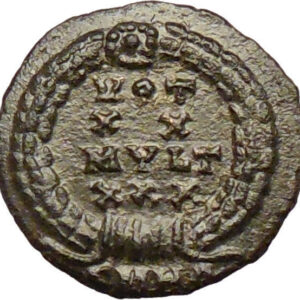|
Vetranio – Roman Emperor: 350 A.D.
Bronze Centenionalis 22mm (5.42 grams) Thessalonica Mint: 350 A.D.
Reference: RIC 132; LRBC 1658
Certification: NGC Ancients XF 4375823-009
D N VETRANIO P F AVG, diademed, draped & cuirassed bust right.
CONCORDIA MILITVM A-B, Vetranio standing facing, holding standard with chi-rho in either hand, star above, dot TSΔ dot in exergue.
You are bidding on the exact item pictured, provided with a Certificate of Authenticity and Lifetime Guarantee of Authenticity.
 The labarum was a vexillum (military standard) that displayed the “Chi-Rho” symbol ☧, a christogram formed from the first two Greek letters of the word “Christ” (Greek: ΧΡΙΣΤΟΣ, or Χριστός) — Chi (χ) and Rho (ρ). It was first used by the Roman emperor Constantine I. Since the vexillum consisted of a flag suspended from the crossbar of a cross, it was ideally suited to symbolize the crucifixion of Christ. The labarum was a vexillum (military standard) that displayed the “Chi-Rho” symbol ☧, a christogram formed from the first two Greek letters of the word “Christ” (Greek: ΧΡΙΣΤΟΣ, or Χριστός) — Chi (χ) and Rho (ρ). It was first used by the Roman emperor Constantine I. Since the vexillum consisted of a flag suspended from the crossbar of a cross, it was ideally suited to symbolize the crucifixion of Christ.
Ancient sources draw an unambiguous distinction between the two terms “labarum” and “Chi-Rho”, even though later usage sometimes regards the two as synonyms. The name labarum was applied both to the original standard used by Constantine the Great and to the many standards produced in imitation of it in the Late Antique world, and subsequently.
 The Chi Rho is one of the earliest forms of christogram, and is used by some Christians. It is formed by superimposing the first two (capital) letters chi and rho (ΧΡ) of the Greek word “ΧΡΙΣΤΟΣ” = KRistos = Christ in such a way to produce the monogram. Although not technically a Christian cross, the Chi-Rho invokes the authority of Jesus, as well as symbolising his status as the Christ. The Chi Rho is one of the earliest forms of christogram, and is used by some Christians. It is formed by superimposing the first two (capital) letters chi and rho (ΧΡ) of the Greek word “ΧΡΙΣΤΟΣ” = KRistos = Christ in such a way to produce the monogram. Although not technically a Christian cross, the Chi-Rho invokes the authority of Jesus, as well as symbolising his status as the Christ.
The Chi-Rho symbol was also used by pagan Greek scribes to mark, in the margin, a particularly valuable or relevant passage; the combined letters Chi and Rho standing for chrēston, meaning “good.” Some coins of Ptolemy III Euergetes (r. 246–222 BC) were marked with a Chi-Rho.
The Chi-Rho symbol was used by the Roman emperor Constantine I (r. 306–337) as part of a military standard (vexillum), Constantine’s standard was known as the Labarum. Early symbols similar to the Chi Rho were the Staurogram (_I_193_2.jpg/20px-Christliche_Symbolik_(Menzel)_I_193_2.jpg) ) and the IX monogram ( ) and the IX monogram (_I_193_4.jpg/20px-Christliche_Symbolik_(Menzel)_I_193_4.jpg) ). ).
Vetranio (d. c. 360), born in the province of Moesia in a part of the region located in modern Bulgaria, is sometimes but apparently incorrectly referred to as Vetriano. He was an experienced soldier and officer when he was asked by Constantina, the sister of Roman Emperor Constantius II, to proclaim himself Caesar (March 1, 350). Her brother Constans had been killed by Magnentius earlier that year and she probably thought Vetranio could protect her family and herself against the usurper. Vetranio accepted and coins were minted in his name, showing the title of Augustus (full emperor), rather than Caesar. Constantius first seemed to accept the new Emperor and sent him money to raise an army, as well as his regalia.
Constantius, who was on a campaign against the Persians when Magnentius came to power, returned to the west and met with Vetranio. Vetranio subsequently abdicated on December 25, 350. He was allowed to live the remainder of his years as a private citizen on a state pension.
|








 The labarum was a vexillum (military standard) that displayed the “Chi-Rho” symbol ☧, a christogram formed from the first two Greek letters of the word “Christ” (Greek:
The labarum was a vexillum (military standard) that displayed the “Chi-Rho” symbol ☧, a christogram formed from the first two Greek letters of the word “Christ” (Greek:  The Chi Rho is one of the earliest forms of christogram, and is used by some Christians. It is formed by superimposing the first two (capital) letters chi and rho (ΧΡ) of the Greek word “ΧΡΙΣΤΟΣ” = KRistos = Christ in such a way to produce the monogram. Although not technically a Christian cross, the Chi-Rho invokes the authority of Jesus, as well as symbolising his status as the Christ.
The Chi Rho is one of the earliest forms of christogram, and is used by some Christians. It is formed by superimposing the first two (capital) letters chi and rho (ΧΡ) of the Greek word “ΧΡΙΣΤΟΣ” = KRistos = Christ in such a way to produce the monogram. Although not technically a Christian cross, the Chi-Rho invokes the authority of Jesus, as well as symbolising his status as the Christ. 




